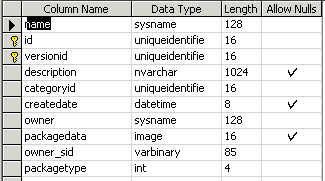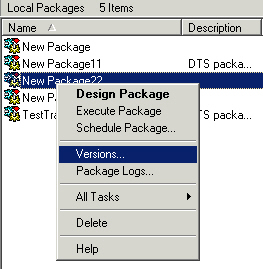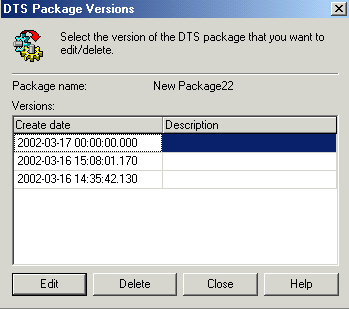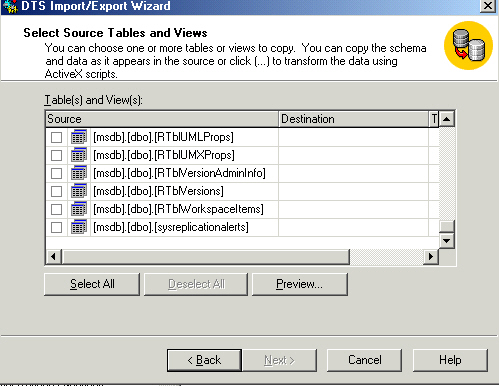We get a LOT of interesting questions in our discussion area. One recent
question was about how to copy a DTS package from one server to another. Seemed
like something worth investigating!
DTS packages can be saved to SQL Server which is the most common, to Visual
Basic code, to a COM structured file, or to the repository. The default is SQL
Server and that's the one I'm to going to focus on in this article. Packages get
saved in MSDB to a table called sysdtspackages, which has the following schema:

Here is some sample data for a small package I created:

As you can see the combination of the ID and the versionid make up the
primary key. Each time you save the package a new row will be added. So when you
design the package, how does it know which is the "current" one? A
quick test revealed that if you right click a package and select execute it uses
the one with the latest createdate. If you want to edit an older version, you
can always do so by selecting versions from the right click menu, then selecting
the one you want to edit:


My first thought was that since the data is stored in a table, let's use DTS
to move the DTS packages! I set up a second named instance of SQL on my machine,
right clicked MSDB and All Tasks, Import Data, then stepped through the wizard
using until I got to the form where you select the tables to copy:

It's not listed! Apparently you can't copy system tables. Ok, kinda makes
sense. My first thought was to just pick a table and save the package, then edit
it to copy the table. Not exactly what I had in mind, but could be made to work.
My next thought was BCP. No reason this shouldn't work, just not as simple to
set up, though maybe a good script or simple front end would fix that. Let's
keep looking and see what the other options are.
The DTS Designer has "save as" functionality that lets you save a
package to a different server. Not what I'd what to do for a couple hundred
packages, but certainly good enough for a few. But how does the Designer do it?
Profiling the source server showed a call to sp_get_dtspackage, checking the
source of that proc revealed it just does some security checking then returns
the row as a recordset. It also calls sp_enum_dtspackages which as you would
expect returns a recordset of packages meeting the criteria passed to it. I then
repeated the "save as" this time tracing the second server. Only one
proc gets called, sp_add_dtspackage, which takes a number of parameters that
match the table schema. Seems like I could do this easily enough from VB.
The solution I posted initially in response to the question was to use VB to
access the DTS package via the COM interface to do the "save as". Here
is a touched up version of the code I posted:
| Sub MoveDTSPackages(SourceServer As String, DestinationServer As String) '3/6/02 Andy Warren 'Code to copy DTS packages using the "save as" functionality built into DTS Dim cn As ADODB.Connection Dim rs As ADODB.Recordset Dim oPackage As DTS.Package On Error GoTo Handler If SourceServer = "" Or DestinationServer = "" Then MsgBox "Must provide both source and destination server names." Exit Sub ElseIf UCase$(SourceServer) = UCase$(DestinationServer) Then MsgBox "Source and destination server names cannot be the same." Exit Sub End If 'establish a trusted connection to source server Set cn = New ADODB.Connection cn.CursorLocation = adUseClient cn.Open "Provider=SQLOLEDB.1;Integrated Security=SSPI;Persist Security Info=False;Initial Catalog=MSDB;Data Source=" & SourceServer 'iterate through all sql packages, open and then save to the destination server Set rs = cn.Execute("select * from msdb..sysdtspackages") Do Until rs.EOF Set oPackage = New DTS.Package With oPackage .LoadFromSQLServer SourceServer, , , DTSSQLStgFlag_UseTrustedConnection,,,,rs.Fields("name") .SaveToSQLServer DestinationServer, , , DTSSQLStgFlag_UseTrustedConnection rs.MoveNext Loop 'clean up rs.Close Set rs = Nothing cn.Close Set cn = Nothing Exit Sub Handler: MsgBox Err.Description Resume Next End Sub |
There are a couple problems with this approach. The first is that when you
use the object model to copy the package, all text annotations are lost. Bug or
feature? The second is that it could potentially cause the wrong package to
become the "default" package since we are not specifying the order of
the select. Easy enough to change the select to order by createdate, but we
still lose the text annotations. Maybe a third issue is whether you would really
want to copy all versions to the other server or just the latest one?
I then modified my code to use ADO to run sp_add_package as listed below.
This did preserve the text annotations in my test package as expected.
| Sub MoveDTSPackages2(SourceServer As String, DestinationServer As String) '3/16/02 Andy Warren 'Code to copy DTS packages using ADO to move the data, a binary copy Dim cnSource As ADODB.Connection Dim cnDestination As ADODB.Connection Dim rs As ADODB.Recordset On Error GoTo Handler If SourceServer = "" Or DestinationServer = "" Then MsgBox "Must provide both source and destination server names." Exit Sub ElseIf UCase$(SourceServer) = UCase$(DestinationServer) Then MsgBox "Source and destination server names cannot be the same." Exit Sub End If 'establish a trusted connection to source server Set cnSource = New ADODB.Connection cnSource.CursorLocation = adUseClient cnSource.Open "Provider=SQLOLEDB.1;Integrated Security=SSPI;Persist Security Info=False;Initial Catalog=MSDB;Data Source=" & SourceServer 'another connection for destination server Set cnDestination = New ADODB.Connection cnDestination.CursorLocation = adUseClient cnDestination.Open "Provider=SQLOLEDB.1;Integrated Security=SSPI;Persist Security Info=False;Initial Catalog=MSDB;Data Source=" & DestinationServer 'iterate through all sql packages Set rs = cnSource.Execute("select * from msdb..sysdtspackages order by createdate") With rs Do Until .EOF Call AddDTSPackage(cnDestination, .Fields("Name"), .Fields("ID"), .Fields("VersionID"), .Fields("Description"), .Fields("CategoryID"), .Fields("Owner"), .Fields("PackageData"), .Fields("PackageType")) .MoveNext Loop End With 'clean up rs.Close Set rs = Nothing cnSource.Close Set cnSource = Nothing cnDestination.Close Set cnDestination = Nothing Exit Sub Handler: MsgBox Err.Description Resume Next End Sub Sub AddDTSPackage(cn As ADODB.Connection, PackageName As String, ID As String, VersionID As String, Description As String, CategoryID As String, Owner As String, PackageData As String, PackageType As Long) Dim cmd As ADODB.Command Dim params As ADODB.Parameters Set cmd = New ADODB.Command ' Set command properties With cmd Set .ActiveConnection = cn .CommandText = "sp_add_dtspackage" .CommandType = adCmdStoredProc Set params = .Parameters End With ' Define stored procedure params and append to command. params.Append cmd.CreateParameter("@RETURN_VALUE", adInteger, adParamReturnValue, 0) params.Append cmd.CreateParameter("@name", adVarWChar, adParamInput, 128) params.Append cmd.CreateParameter("@id", adGUID, adParamInput, 0) params.Append cmd.CreateParameter("@versionid", adGUID, adParamInput, 0) params.Append cmd.CreateParameter("@description", adVarWChar, adParamInput, 255) params.Append cmd.CreateParameter("@categoryid", adGUID, adParamInput, 0) params.Append cmd.CreateParameter("@owner", adVarWChar, adParamInput, 128) params.Append cmd.CreateParameter("@packagedata", adVarBinary, adParamInput, 2147483647) params.Append cmd.CreateParameter("@packagetype", adInteger, adParamInput, 0) ' Specify input parameter values params("@name") = PackageName params("@id") = ID params("@versionid") = VersionID params("@description") = Description params("@categoryid") = CategoryID params("@owner") = Owner params("@packagedata") = PackageData params("@packagetype") = PackageType ' Execute the command cmd.Execute , , adExecuteNoRecords 'done Set cmd = Nothing End Sub |
I think it's safe to assume that BCP would work equally well, or even TSQL
doing an insert using a linked server. Of course even a successful copy to the
new server doesn't guarantee it will work correctly - you still may need to
change paths, servernames, passwords, create folders, or even add other external
support files to the server. I don't see an easy way to do that in an automated
fashion.
If you're new to DTS our own Brian
Knight co-authored a book on the subject which Steve Jones has reviewed.
Steve also has an article about saving
packages using COM storage rather than on the server you might want to read.
Questions or comments?


